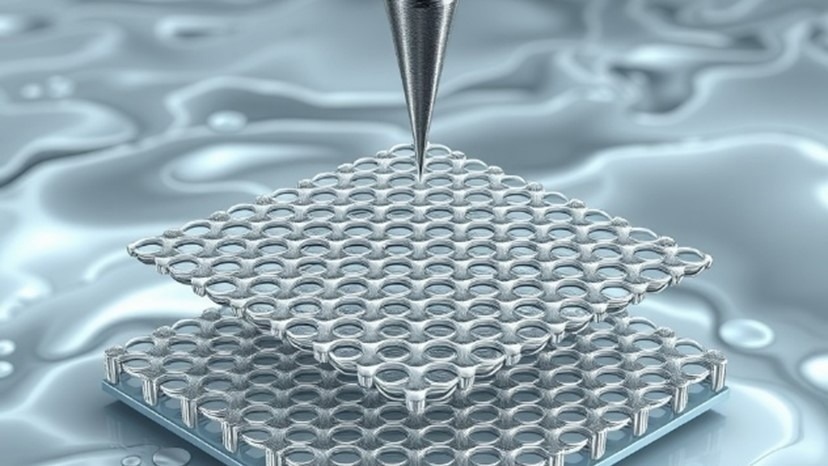Reviewed by Lexie CornerFeb 25 2025
Chemists from the National University of Singapore (NUS) imaged the dynamic assembly of bilayer covalent organic frameworks (COFs) in solution, providing new insights into moiré superlattice formation and controlled stacking. The study was published in Nature Chemistry.
 A scanning tunneling microscopy (STM) study of moiré superlattice formation on a twisted bilayer covalent organic framework (COF). Image Credit: National University of Singapore
A scanning tunneling microscopy (STM) study of moiré superlattice formation on a twisted bilayer covalent organic framework (COF). Image Credit: National University of Singapore
When one lattice is rotated relative to another in a stacked structure, a new correlated electron phase can emerge. The moiré superlattice is a key concept in the field of "twistronics." In a correlated electron phase, the interactions between electrons significantly affect their properties, rather than behaving as individual particles. This can lead to unique phenomena such as ferromagnetism or superconductivity.
Pure organic crystals are less likely to exhibit moiré superlattice formation than pure inorganic materials. One reason is that for moiré superlattice imaging using traditional microscopy techniques, the material must be extremely thin and crystalline - characteristics that are difficult to achieve in organic materials.
Two-dimensional covalent organic frameworks (2D COFs) are highly porous organic materials with significant potential for applications in gas storage, energy storage, and catalysis. These structures are made up of covalently bonded layers stacked by van der Waals forces and electrostatic interactions. However, the transition from a monolayer to a bilayer is poorly understood due to the complex interactions of bonding forces such as van der Waals, electrostatic, and hydrogen bonding.
The second layer in these materials must be precisely aligned, as misalignment can reduce the crystallinity of the material. Producing single COF crystals larger than a millimeter is difficult due to potential bonding errors in both the horizontal (x-y) and vertical (z) dimensions.
Crystallinity issues often arise from misalignment during stacking, especially when rotational misalignments occur between layers. Observing the stacking process during growth is essential to understanding this mechanism, but this is challenging because the process occurs in solution.
Poor crystallinity is a result of random stacking and bond formation during hydrothermal synthesis, which often results in crystal domains smaller than tens of microns. A better understanding of layer stacking could improve synthesis methods and enable the production of larger COF crystals.
While the synthesis of monolayer 2D polymers (2DP) has made significant progress, the development of bilayer 2DP stacks is still in its early stages. Since 2D materials can be stacked or twisted to create new materials with properties distinct from the individual layers, this area has great potential. Twistronics has led to breakthroughs in inorganic materials but remains largely unexplored in 2D organic materials.
Breakthrough in Bilayer COF Synthesis and Imaging
A team from the NUS Department of Chemistry, under the direction of Professor Loh Kian Ping, has created a technique for creating large-area two-layer 2D COFs at the liquid-substrate interface. Chemical molecules were directly condensed, and the team used scanning tunneling microscopy (STM) in solution to image the molecular assembly process and capture the formation of both the monolayer and bilayer.
The team also demonstrated how solvent mixtures and molecular structures influence bilayer stacking modes, showing that twisted bilayer stacking can produce large-area moiré superlattices under certain conditions.
COFs present a significant challenge for STM imaging in air or ultra-high vacuum (UHV) conditions due to their highly porous and organic nature. Solvents often fill the pores of COFs, and residues can become trapped on their surfaces, complicating atomic-scale imaging. By imaging COFs directly in solution, where the surface is cleaner than when exposed to air, the team overcame these challenges.
Performing STM in solution allows us to study the dynamic self-assembly process of molecular frameworks in real-time.
Loh Kian Ping, Professor and Study Lead, Department of Chemistry, National University of Singapore
Moiré Superlattices and Controlled Twist Angles
When two layers of periodic structures, such as 2D materials, are stacked with slight misalignment or at different angles, a moiré superlattice is formed. This misalignment produces a new periodic pattern that is absent in either of the original layers. A simple analogy is stacking two sets of paper strips and slightly rotating them, resulting in a new pattern.
Moiré superlattices are significant in condensed matter physics and materials science because they can induce unique electronic behaviors and properties not found in the individual layers.
The researchers demonstrated that they could precisely control the twist angle of stacked COF layers to create a moiré superlattice by designing specific precursor molecules. Unlike inorganic 2D materials, where twist angles are often unpredictable and difficult to control, 2D COFs enable twist angle regulation through the design of molecular precursors.
The researchers compared two distinct monomer isomers: pyrene-2,7-diboronic acid (27-PDBA) and pyrene-1,6-diboronic acid (16-PDBA). The second layer of 27-PDBA could be twisted relative to the first layer or aligned in an AA-stacked configuration. In contrast, 16-PDBA only formed a uniform moiré superstructure. This difference arises from variations in electrostatic potentials. Unlike 16-PDBA, which has a flatter electrostatic potential, 27-PDBA features concentrated negative charge lobes on its boroxine rings, which may hinder the formation of twisted phases.
Implications and Future Directions
The controlled synthesis of ultra-thin porous organic films, as thin as two-unit cell layers, is now better understood. These films, with precisely regulated channel structures, can function as ultra-thin filtration layers in nanofiltration applications. Moreover, the ability to adjust the twist angle in stacked COFs opens up new possibilities for controlling the phase and polarization of light propagation.
In the future, the researchers aim to extend this concept to a broader range of molecular precursors with different linkage chemistries. Their goal is to achieve deterministic control over twist angles in bilayer COF stacking, which could unlock further applications in filtration and optical materials.
Journal Reference:
Zhan, G., et al. (2025) Moiré two-dimensional covalent organic framework superlattices. Nature Chemistry. doi.org/10.1038/s41557-025-01748-5